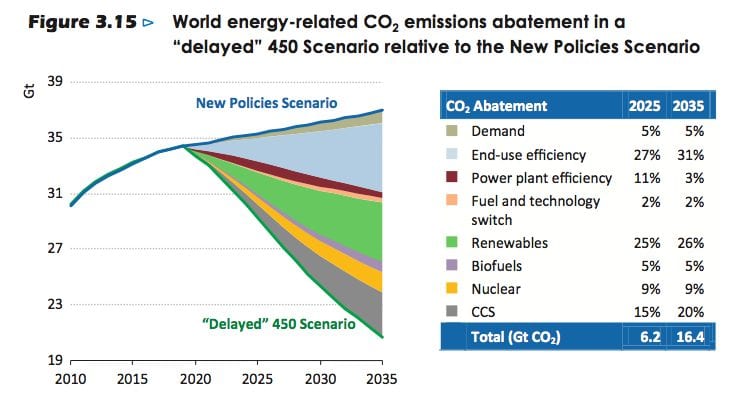It is staggering to observe that even in modern sophisticated economies such as the US, Australia and UK – which are supposed to have modern, sophisticated political systems (no really, don’t laugh) – that the role of renewables in the world’s future energy systems is constantly underplayed.
This has probably got something to do with the way that mainstream media handles the issue. In its pursuit of division, fear and controversy, it’s happy to oblige the tactics of delay and misinformation from the fossil fuel industry, that is seeking to protect and prolong several trillion dollars of investments and revenue streams.
Too often, renewable energy is portrayed as an expensive and unnecessary plaything or indulgence. But the media is not solely to blame. There is a shocking lack of vision at the political level too, with the notable exception of the Greens. Conservative political parties, in Australia in particular, constantly use green energy as a scapegoat for problems elsewhere; often for superfluous and inefficient grid upgrades.
But one thing should be made clear: whichever way you cut the future energy outlook, and whichever way you attack the challenge of climate change and the goal of reducing emissions, two technology solutions dominate all others – energy efficiency and renewable energy.
Even if the pro-nuclear lobbies and those who still hold on to the dream of carbon capture and storage have their way, the investment in those technologies will pale in comparison to that needed for renewables – be it in solar PV or solar thermal with storage, wind energy (onshore and offshore), hydro, biomass, or the emerging technologies such as wave and tidal.
This is true on two counts. Already, solar PV – and the arrival of socket parity in more than 100 countries – is providing an economic rationale for investment in renewables, regardless of climate policies. Utility-scale wind is cheaper than new fossil fuel plants in many countries – particularly in energy starved developing nations in Africa and Asia – and utility-scale solar will follow soon enough. Once climate policy is taken into the equation, the impact is even more dramatic.
This first graph below – taken from the International Energy Agency’s recent “Redrawing the climate energy map” publication – probably best sums up the situation. It is the IEA’s take on where the greatest emissions reductions are going to take place in the energy industry if the world is going to meet its climate goals. This graph illustrates its “delayed” scenario, which takes into account the probability that governments will not ramp up their policy actions by 2014 – as would be prudent – but would delay a few years.
Energy efficiency and renewable energy sources account for well over half of the abatement. Nuclear and CCS – even if they meet the IEA’s optimistic scenarios, which, given the financing problems for nuclear and the technology challenges for CCS, is unlikely – they still account for less than one-quarter of anticipated abatement. If either of those two technologies fall short, then energy efficiency and renewables will have to take up the slack.
Given this, there are no prizes for guessing where the best returns are going to be made over the next two decades, a key factor that seems to go largely absent when renewables are discussed in the frame of short terms costs and not in the context of long-term opportunities.
This next graph illustrates this point. It’s the difference between policies that have been promised and enacted by leading economies so far (the blue New Policies scenario), and the policies required to meet the climate goals (green). Either way, revenues from renewables outstrip those from new nuclear and fossil fuel plants combined, even if nothing more is done, and are nearly double when the world takes serious action. Could there be any clearer demonstration of where the future is?
The political debate in Australia around fossil fuels – and by extension renewables – is still based on the assumption that international demand is inexhaustible as the growing middle classes of emerging superpowers such as India and China require more electricity to power their new gadgets and appliances.
But the IEA makes clear that renewables will dominate the world’s new capacity – even out to 2020 – with some $2 trillion likely to be invested in hydro, wind, solar, biomass and other renewables. Australia’s share of that, with current policies such as the 20 per cent renewable energy target (should it be retained) is a modest $20 billion. That does not even meet our pro-rata share on a population basis.
“Despite the insufficiency of global action to date, limiting the global temperature rise to 2 °C remains technically feasible, though it is extremely challenging,” the IEA says.
“To achieve our 450 Scenario, which is consistent with a 50% chance of keeping to 2 °C, the growth in global energy-related CO2 emissions needs to halt and start to reverse within the current decade. Clear political resolution, backed by suitable policies and financial frameworks, is needed to facilitate the necessary investment in low-carbon energy supply and in energy efficiency.” Can’t be any clearer than that.
Still, the fossil fuel industry, and particularly the Australian Coal Association, has its head stuck firmly in the ground. Its CEO Nikki Williams is insisting that there is no such thing as “unburnable carbon”, and that all carbon can, and should be burned.
It’s a premise based on the hope that CCS will deliver, and deliver on time. Curiously, the coal industry has done precious little to fund the research, but it still hangs on its promise. Williams’ hopes are based on a business-as-usual scenario – or, at best, the New Policies scenario. But as the IEA points out in the graph below, even with CCS – the total market for coal-fired power stations is going to fall dramatically in the coming decades. Unless, of course, we just ignore the climate.











